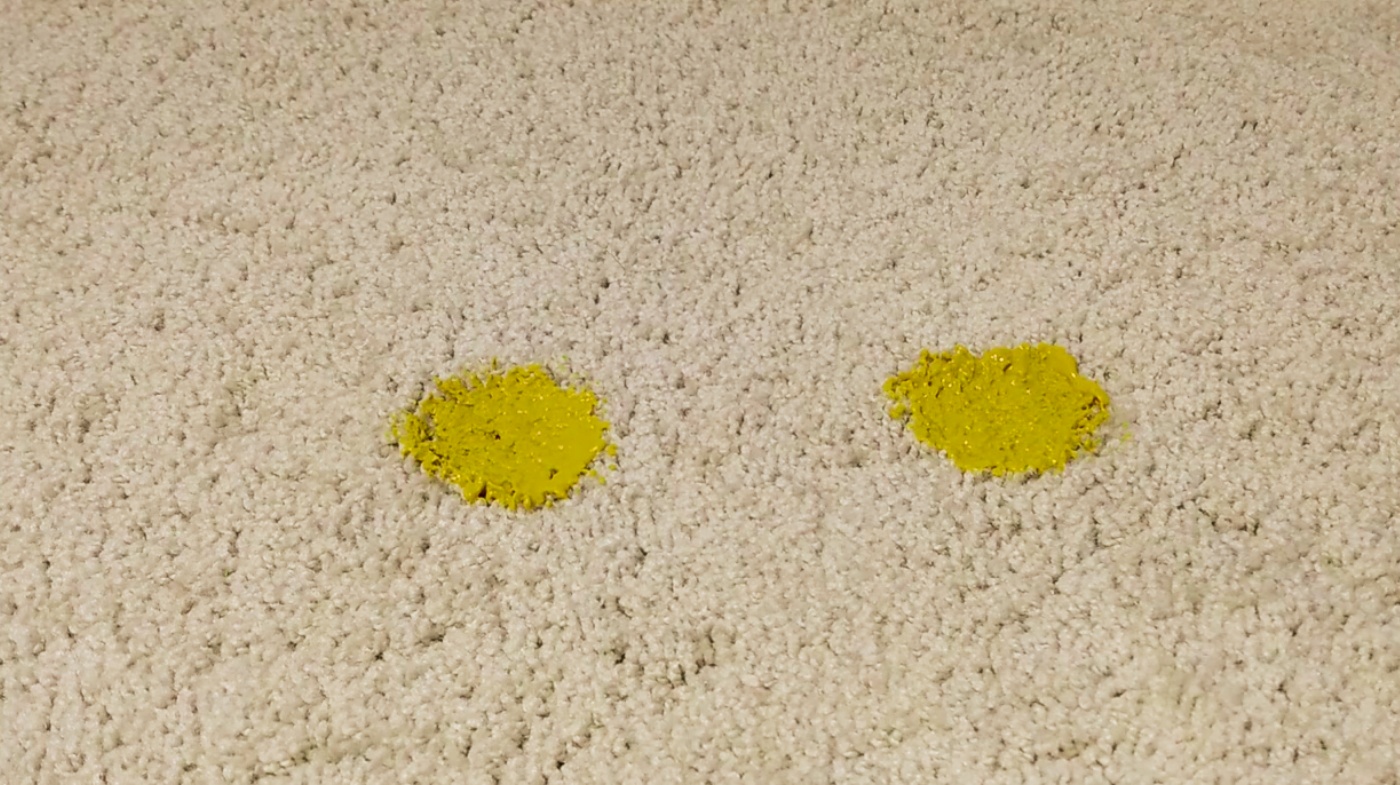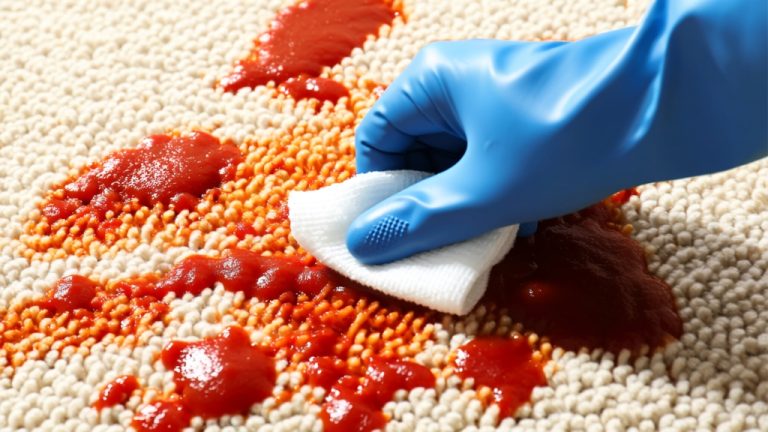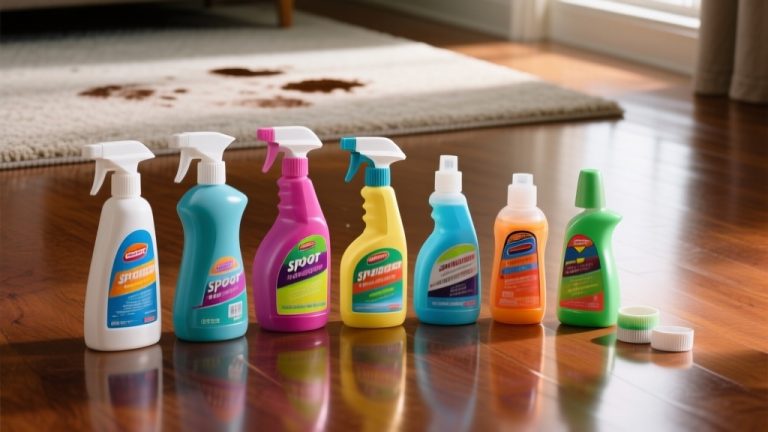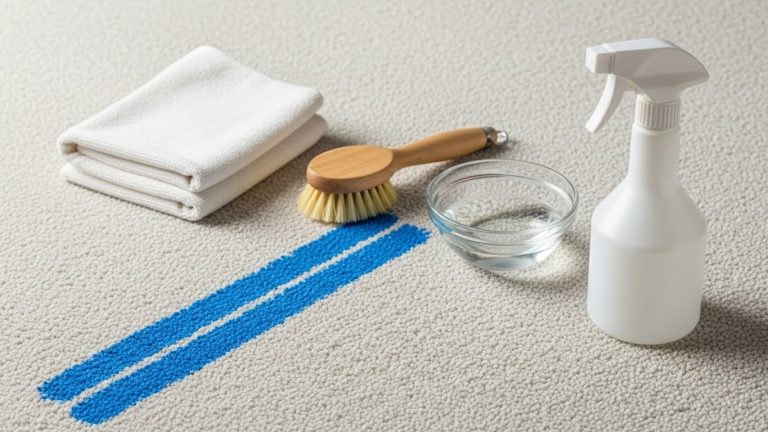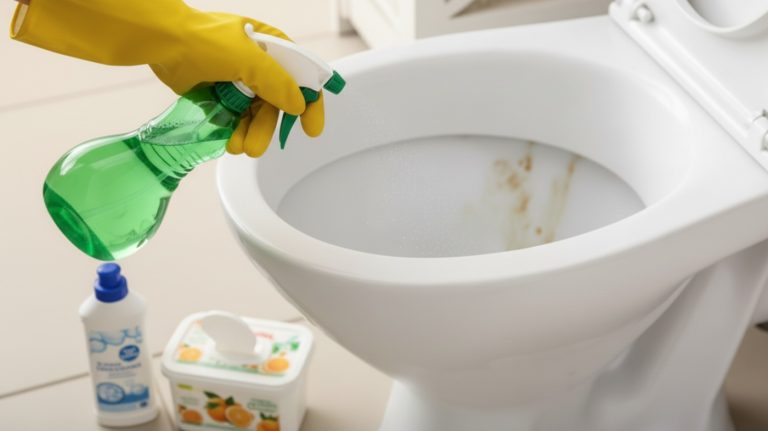How to Get Rid of Turmeric Stains on Carpet? Proven Tricks
If turmeric spills on your carpet, act quickly by removing solids gently and blotting with a white cloth and cold water.
Prepare a mixture of baking soda, water, and dish soap for mild stains or hydrogen peroxide combined with dish soap for tougher ones—always test first on a hidden area.
Apply cleaning solutions gently and blot rather than scrub to avoid fiber damage. For persistent stains, using glycerin or commercial cleaners may be necessary. Additional strategies can guarantee complete stain removal and carpet care.
Key Takeaways
- Act quickly by gently removing solids and blotting the turmeric stain with cold water and absorbent cloths from the outside inward.
- Mix a cleaning solution of baking soda, dish soap, and cold water; apply, let sit, then scrub gently to lift the stain.
- Use hydrogen peroxide with a few drops of dish soap on tough stains, applying with a soft brush and letting it sit before blotting.
- For mild stains, spray a glycerin and water mixture, let it sit 15-30 minutes, then blot and rinse with a damp cloth.
- Test commercial enzymatic or oxygen-based cleaners on a hidden area, pre-treat stains promptly, and blot gently for effective removal.
Immediate Steps to Take When Turmeric Spills on Carpet
When turmeric spills on your carpet, act immediately to prevent the stain from setting. First, remove any solid particles gently using a spoon or card edge—avoid pushing them deeper into fibers. Remove dry spice or paste with a spoon to minimize initial staining.
Surround the spill with absorbent materials like paper towels to contain it and prevent spreading. Use clean, white cloths to blot the stain carefully, working from the outside inward. Avoid rubbing or scrubbing, as this embeds pigment further and damages fibers.
Dab the area with cold water to dilute the turmeric; never use hot water, which fixes stains. Blot repeatedly with fresh cloths to lift pigment effectively.
Preparing Homemade Cleaning Solutions for Turmeric Stains
To prepare effective homemade cleaning solutions for turmeric stains, follow these simple steps:
Essential Cleaning Ingredients
Although turmeric stains can be stubborn, you can prepare effective homemade cleaning solutions using a select group of essential ingredients.
Baking soda serves as a natural, non-toxic cleaning agent that absorbs turmeric’s oily components and lifts stains when combined with dish detergent and water.
Blot the stain with a dry white cloth or paper towels first to absorb excess moisture before applying any cleaning mixture.
Glycerin acts as a mild solvent, softening stain particles for easier removal. Liquid dish detergent contains surfactants that break down turmeric pigments and oils, enhancing stain extraction, especially when diluted.
Hydrogen peroxide, diluted typically 9:1 with water, functions as a mild bleaching agent for tough, set-in stains but requires spot testing to avoid discoloration. Coconut oil’s fatty acids disrupt turmeric’s oily base, facilitating stain lifting.
Mixing Effective Solutions
Since turmeric stains combine oily and pigmented components, mixing an effective homemade cleaning solution requires balancing absorbent, surfactant, and oxidizing agents.
Start by dissolving a teaspoon of baking soda in a cup of cold water to leverage its absorbency. Add a few drops of dish soap to target the oil-based residue effectively.
For enhanced stain breakdown, cautiously incorporate a small amount of hydrogen peroxide, guaranteeing you test on an inconspicuous carpet area first to prevent color loss. Avoid hot water to prevent stain setting.
Hydrogen peroxide is particularly effective because it can be activated by UV light to break down the curcumin molecules in turmeric.
Mix gently to maintain solution integrity. Apply the mixture sparingly with a soft cloth, allowing it to penetrate the fibers for several minutes before blotting.
Techniques for Applying Cleaning Agents to Carpet Stains
To effectively treat turmeric stains without damaging your carpet, below are the recommended techniques for applying cleaning agents safely and efficiently.
Blotting and Dabbing
To effectively remove turmeric stains from carpet fibers, you’ll want to focus on blotting and dabbing techniques rather than scrubbing. Blotting uses gentle pressure to lift the stain without damaging fibers or spreading the discoloration.
Use a clean, white microfiber cloth or paper towel pre-moistened with a mild cleaning solution. Always work from the stain’s outer edge inward to avoid enlarging the affected area. It is important to remember that blotting is gentler and helps retain the carpet’s color by not pushing dye deeper into the fibers.
Key points for effective blotting and dabbing:
- Press gently, don’t rub, to prevent fiber damage and stain spread.
- Change cloth sections frequently to avoid re-depositing the stain.
- Avoid saturating the carpet; over-wetting can cause water rings or mildew.
- After blotting, allow the carpet to air dry fully before resuming use.
Gentle Scrubbing Methods
Although blotting is essential for initial stain removal, gentle scrubbing becomes necessary to fully lift turmeric residues embedded in carpet fibers.
Prepare a mild cleaning solution by mixing one teaspoon of bleach-free dish soap with one cup of cool or warm water, adding baking soda for enhanced stain-lifting. This mixture works similarly to the baking soda and dish soap paste commonly recommended for fabric stains.
Lightly dampen a clean cloth or sponge—avoid over-wetting—and apply the solution by blotting, then use a soft brush with minimal pressure in a circular motion from the stain’s perimeter inward.
Rinse residues with cold water using a fresh cloth, blotting gently to absorb moisture. Repeat these cycles patiently to avoid fiber damage.
For delicate carpets, use fiber-appropriate cleaners or glycerin solutions. Always test on hidden areas first to guarantee fabric safety.
Using Baking Soda to Lift Fresh and Dried Turmeric Stains
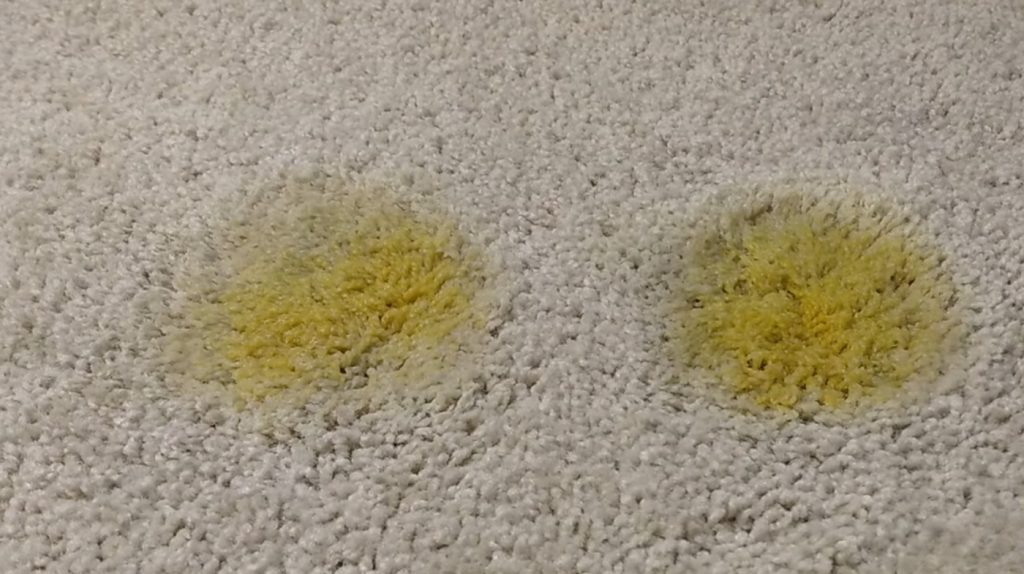
Since turmeric stains can be both fresh and dried, you’ll need to rehydrate dried spots by dampening them before applying a baking soda-based cleaning solution.
Start by blotting fresh stains to remove excess moisture. Then, mix baking soda, dish soap, and water to create your cleaning solution. Apply it directly to the stain with a cloth or soft brush, working from the outside in to avoid spreading.
- Let baking soda sit for several minutes to absorb the stain.
- Gently scrape away the baking soda with a butter knife.
- Scrub the area using a dish soap and water solution.
- Wipe with a clean, damp cloth and allow to air dry. For dried stains, dampen the area and repeat the baking soda method.
Repeat if necessary for stubborn stains, taking care to protect carpet fibers.
Employing Hydrogen Peroxide and Dish Soap for Tough Stains
When baking soda and dish soap don’t fully remove stubborn turmeric stains, employing a mixture of hydrogen peroxide and dish soap can provide a stronger cleaning effect.
Start by pouring hydrogen peroxide directly onto the stain, then add a few drops of dish soap. Use a soft toothbrush to gently work the solution into the fibers.
Let it sit for 30 minutes to break down the turmeric dye effectively. Afterward, blot with a clean, damp cloth to lift residual solution and stain.
Always perform a patch test on an inconspicuous area before full application to avoid discoloration. Use hydrogen peroxide cautiously, as prolonged exposure risks fading carpet fibers.
Gentle Methods for Treating Mild Turmeric Stains With Glycerin
If you’re dealing with mild turmeric stains, glycerin offers a gentle yet effective cleaning option that minimizes fiber damage.
Start by mixing equal parts glycerin and water in a spray bottle. Test the solution on an inconspicuous carpet area to verify colorfastness.
Dampen the stained area with lukewarm water, then blot excess moisture using a clean towel. Acting quickly is crucial because treating stains promptly makes removal easier.
Spray the glycerin mixture evenly on the stain and let it sit for 15–30 minutes to dissolve pigments. Avoid rubbing; instead, blot repeatedly and gently brush in circular motions from the edges inward. Rinse residue with a water-dampened cloth and air-dry the carpet.
- Use a 1:1 glycerin-to-water ratio for ideal viscosity
- Treat fresh stains within hours for best results
- Repeat application if discoloration persists
- Add mild dish soap during final rinse to enhance cleaning
Advanced Approaches for Stubborn and Set-In Turmeric Stains
Mild turmeric stains often respond well to glycerin-based treatments, but more persistent or set-in discolorations demand stronger interventions.
Begin with hydrogen peroxide, a potent oxidizing agent that breaks down curcumin molecules. Enhance its effect by exposing the treated area to UV light, which generates hydroxyl radicals for deeper stain degradation. This advanced oxidation reaction effectively destroys the curcumin molecules responsible for yellow stains.
Apply the solution carefully, testing a hidden carpet section first to verify colorfastness. Repeat applications may be necessary for stubborn stains.
For mechanical assistance, use specialized stain removal tools or professional carpet cleaning machines combined with wet vacuuming to extract moisture and prevent re-staining.
Combining detergent solutions with hydrogen peroxide and baking soda can further improve removal efficiency. Avoid bleach unless absolutely necessary due to its risk of damaging carpet dyes.
Choosing Commercial Products for Effective Turmeric Stain Removal
Although turmeric stains can be challenging, selecting the right commercial carpet cleaner greatly improves removal outcomes. You should first identify your carpet fiber type and the stain’s age to choose an effective product.
Enzymatic cleaners break down turmeric’s organic dyes, oxygen-based removers bleach stubborn pigments, and solvent-based cleaners dissolve oily residues. Always test a cleaner on a hidden spot to guarantee fiber safety.
Follow these guidelines for best results:
- Pre-treat the stain promptly and apply cleaner with a white cloth, blotting gently. Act quickly to prevent the stain from setting is crucial in improving the chances of removal.
- Use soft-bristle brushes or spray bottles for even application.
- Repeat treatments or combine products for set-in stains.
- Wear gloves and ventilate areas when handling solvents or peroxides.
Tips for Preventing and Maintaining Carpet Cleanliness After Stain Removal
While removing turmeric stains effectively is essential, maintaining carpet cleanliness afterward guarantees long-term fiber integrity and appearance.
Vacuum frequently, especially in high-traffic areas, using a high-efficiency filter vacuum certified by reputable organizations to prevent soil embedment. This reduces buildup of dirt and allergens, helping maintain a healthy indoor environment.
Address spills immediately by blotting gently with clean cloths and applying carpet-safe, cool water–based cleaners after testing in inconspicuous areas.
Schedule professional deep cleaning every 12 to 18 months using certified products aligned with manufacturer guidelines to remove embedded residues and restore texture.
Employ protective measures like mats at entrances, area rugs in vulnerable zones, and carpet protector treatments to minimize wear and facilitate cleanup.
Additionally, trim snags, rotate furniture, and control indoor humidity around 40% to maintain fiber pliability and prevent deterioration, ensuring your carpet remains clean and resilient long-term.
Frequently Asked Questions
Can Turmeric Stains Cause Permanent Carpet Fiber Damage?
Turmeric stains themselves don’t cause permanent carpet fiber damage, but their pigments can embed deeply if untreated.
You risk fiber weakening if you use harsh chemicals or aggressive scrubbing to remove stains later. Prompt, gentle cleaning minimizes pigment penetration and fiber degradation.
Using diluted hydrogen peroxide and mild detergents helps break down pigments without harming fibers.
Are Turmeric Stains Harmful to Pets or Children?
Imagine turmeric stains like a colorful but harmless ghost in your home—visible but not dangerous. You don’t have to worry about toxicity since turmeric isn’t harmful to pets or children in small amounts.
However, keep in mind that large quantities might trigger allergies or cause skin irritation. Always make certain turmeric powder doesn’t become a choking hazard by keeping it away from curious little ones or pets.
How Long Does Turmeric Stain Removal Usually Take?
You’ll find turmeric stain removal times vary based on stain age, severity, and carpet type. Light stains usually clear within 30 minutes if you act quickly.
Moderate stains take 30 to 60 minutes, requiring repeated cleaning. Severe or set-in stains might need several hours or days, including drying.
Professional cleaning can reduce this to under an hour. Always consider multiple treatments for complete removal and factor in drying time.
Can Turmeric Stains Be Removed From All Carpet Materials?
You can remove turmeric stains from many carpet materials, but not all respond equally. Synthetic fibers like nylon and polyester generally allow easier stain removal, while natural fibers such as wool and silk bind turmeric’s pigment tightly, often causing permanent discoloration.
The effectiveness depends on fiber type, stain age, and cleaning method. Testing cleaners on hidden spots and acting promptly improves your chances, but some stains might remain despite thorough treatment.
Does Turmeric Stain Removal Affect Carpet Color or Texture?
You might think turmeric stains are tiny explosions of color, but removing them demands caution. Using harsh chemicals like hydrogen peroxide can fade your carpet’s hues and weaken fibers over time.
Instead, opt for gentle agents like baking soda or glycerin to protect texture and color. Avoid excessive scrubbing and moisture, as these can distort fibers. Always act promptly and consider professional advice to maintain your carpet’s vibrant look and integrity.
Restoring Carpet Beauty: Say Goodbye to Turmeric Stains for Good
Think of turmeric stains as stubborn weeds in your carpet’s garden. By acting swiftly with the right cleaning solutions—whether homemade or commercial—you uproot these blemishes before they take root.
Using targeted methods like baking soda, hydrogen peroxide, or glycerin, you methodically restore your carpet’s original hue.
Consistent care and prevention become your watering can, ensuring your carpet stays vibrant and spotless, ready to withstand future spills with resilience and precision.

